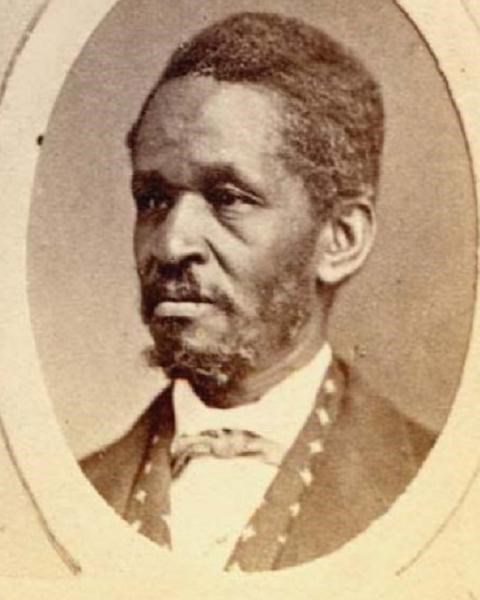Last updated: January 16, 2023
Person
Lewis Hayden

State Library of Massachusetts
A leader of Boston’s Black community on Beacon Hill, Lewis Hayden took on causes for the protection and benefit of those in his community and beyond.
Born enslaved in Kentucky, Lewis Hayden spent the first decades of his life in slavery. His first wife, Esther Harvey, and son had been sold to Kentucky politician Henry Clay, who later sold them to another slave trader; Hayden never saw them again.1 He married Harriet Hayden in 1842, and with their son, Joseph, they escaped to freedom in the mid-1840s. The Haydens traveled to Detroit and then Canada. At some point, most likely in 1845, they had their daughter, Elizabeth. They eventually settled in Boston, where Lewis established a successful clothing store.2
An integral figure in Boston’s Underground Railroad network, Lewis Hayden assumed numerous duties in the local abolitionist movement. He served on the executive committee of the Boston Vigilance Committee, and his and Harriet’s home became a meeting place for abolitionists and a safe house for freedom seekers. Numerous Vigilance Committee records note Lewis Hayden (likely with the help of Harriet) boarding freedom seekers, raising funds, donating clothes, and transporting freedom seekers outside of Boston.3
Lewis Hayden’s support for freedom seekers and abhorrence for the 1850 Fugitive Slave Law led to direct and sometimes dangerous action. In 1850, Hayden protected William and Ellen Craft, who had escaped from Georgia two years earlier and had recently been the subject of warrants for their return to slavery. Sheltering William Craft, Hayden barricaded his doorway and threatened slavecatchers if they pursued the Crafts.4 In two instances, Lewis Hayden led raids on the Boston Courthouse; first in the rescue of Shadrach Minkins in 1851 and second in the unsuccessful attempt to free Anthony Burns in 1854.5
In addition to his Underground Railroad work, Lewis Hayden played other prominent roles in his community. He served as Grand Master of the Prince Hall Masons and presided over numerous community meetings, particularly those in response to the Fugitive Slave Law. In the 1850s, he worked with other community leaders, such as William Cooper Nell, in the struggle to integrate Boston Public Schools.6 In the late 1850s, he began serving as Messenger to the Secretary of State, a politically appointed position which gave him access to many high profile leaders in state government. Likely one of the first Black state employees, Hayden held this position for 30 years.7
During the Civil War, Lewis Hayden recruited Black soldiers for the Massachusetts civil war regiments, including the Massachusetts 54th Infantry Regiment. Following the Civil War, Hayden served as one of the first Black members of the Massachusetts General Court, an elected representative in the state legislature.8 As a representative, Lewis Hayden lent his support in the fight for women’s suffrage, serving on the Committee on Woman Suffrage and advocating for legislative measures to provide women with the right to vote. Remembering the work of women in the abolitionist movement, Hayden recalled, "My race can never repay the debt we owe to such as these [suffragists]. I should be indeed an ingrate, if I did not work and vote for the enfranchisement of women."9
When Hayden died in 1889, William Bowditch wrote, "Lewis Hayden’s career from first to last ought to prove a beacon light to every one of us. God grant that we may not shut our eyes to the way it points out to us."10
Learn more...
Lewis and Harriet Hayden House
Fighting for Freedom: Lewis Hayden and the Underground Railroad
Footnotes
- Stephen Kantrowitz, More Than Freedom: Fighting for Black Citizenship in a White Republic, 1829-1889 (New York: Penguin, 2012) 90.
- James Horton and Lois Horton, Black Bostonians: Family Life and Community Struggle in the Antebellum North (New York: Holmes & Meier Publishers, Inc., 1999) 58; Kathryn Grover and Janine V. Da Silva, "Historic Resource Study: Boston African American National Historic Site," Boston African American National Historic Site, (2002), 93-94.
- See Account Book of Francis Jackson, Treasurer The Vigilance Committee of Boston, Dr. Irving H. Bartlett collection, 1830-1880, W. B. Nickerson Cape Cod History Archives, https://archive.org/details/drirvinghbartlet19bart/page/n3/mode/2up; Grover and Da Silva, "Historic Resource Study: Boston African American National Historic Site," 93-95.
- Horton and Horton, Black Bostonians, 112-113; Grover and Da Silva, "Historic Resource Study: Boston African American National Historic Site," 95-97.
- Horton and Horton, Black Bostonians, 114, 117-118; Grover and Da Silva, "Historic Resource Study: Boston African American National Historic Site," 98-99.
- Horton and Horton, Black Bostonians, 82.
- Horton and Horton, Black Bostonians, 86; Grover and Da Silva, "Historic Resource Study: Boston African American National Historic Site," 100.
- Grover and Da Silva, "Historic Resource Study: Boston African American National Historic Site," 100.
- 1873 House Bill 0122. Resolve Providing For An Amendment Of The Constitution To Secure The Elective Franchise And The Right To Hold Office To Women, Massachusetts State Library, https://archives.lib.state.ma.us/handle/2452/742347; “Lewis Hayden Obituary,” The Woman’s Journal (Apr 13, 1889), Schlesinger Library, Radcliffe Institute, Harvard University, https://iiif.lib.harvard.edu/manifests/view/drs:49020444$123i.
- Henry Ingersoll Bowditch, Life and Correspondence of Henry Ingersoll Bowditch. Volume II (Cambridge: The Riverside Press, 1902), 350-351, https://archive.org/details/lifecorresponden02bowd/page/350/mode/2up.
